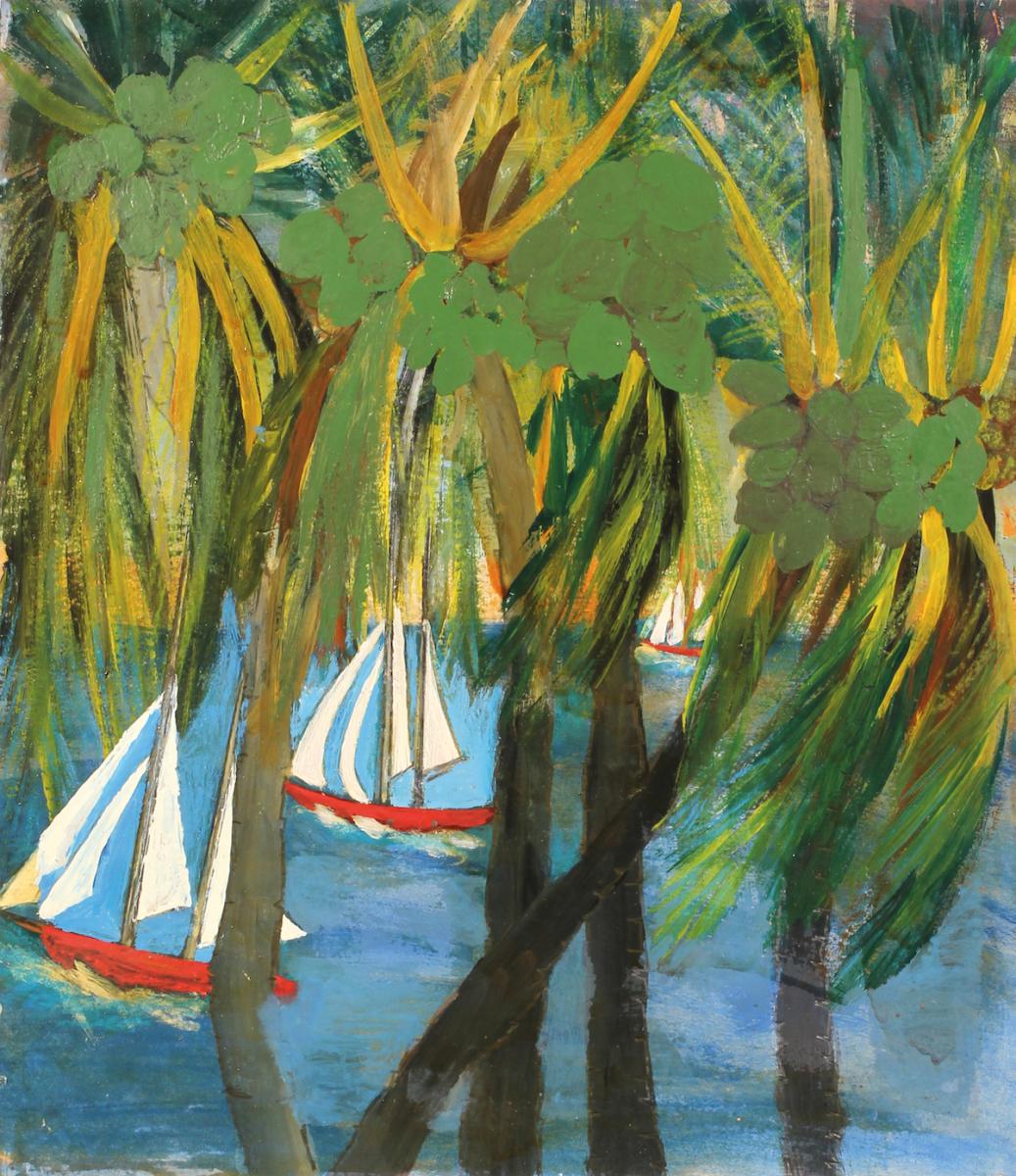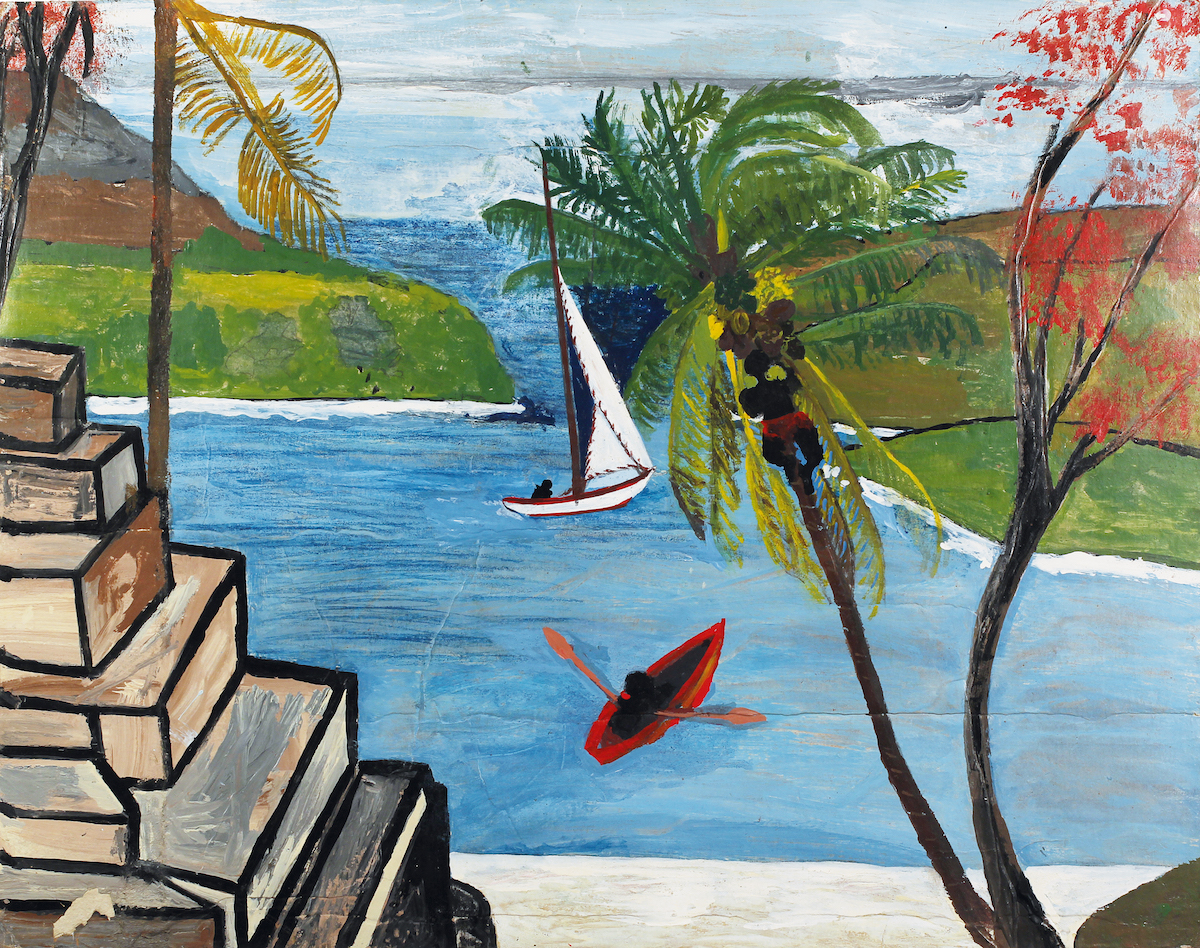This wonderful Cornish workshop and museum is dedicated to the legacy of studio pottery trailblazer Bernard Leach
Frank Walter: artist, gardener, radical
Frank Walter: artist, gardener, radical
12 Oct 2023
Who was Frank Walter, self-styled 7th Prince of the West Indies, Lord of Follies and the Ding-a-Ding Nook? As an exhibition of his art opens at London’s Garden Museum, curator Barbara Paca reveals his story
Modern Tropical Flowers (undated), oil on wood. Image: courtesy Frank Walter Family and Kenneth M Milton Fine Arts
London’s Garden Museum has been transformed into a lush Caribbean environment with the staging of Frank Walter: Artist, Gardener, Radical. To view is to enter the universe of Francis Archibald Wentworth Walter of Antigua.
From the seductively beautiful landscapes of the Caribbean Leeward Islands to English countryside and European cities, Frank Walter (1926–2009) led an exploratory, cinematic life. Wherever he travelled, his artistic output was prolific. It included painting, poetry and sculpture. He was also a philosopher, environmentalist and composer. Today he is viewed as one of the most significant visual artists of the 20th and 21st centuries; this exhibition is the first retrospective of his work in an English venue.
 Sailboats through Coconut Palms (undated), oil on card. Image: courtesy Frank Walter Family and Kenneth MMilton Fine Arts
Sailboats through Coconut Palms (undated), oil on card. Image: courtesy Frank Walter Family and Kenneth MMilton Fine Arts
Walter was a direct descendant of both enslaved persons and plantation owners. During the 1950s he became increasingly interested in his own genealogy, believing himself to be related to King Charles II through the white enslavers in his ancestry. This led to his self-titling of ‘7th Prince of the Caribbean’ and more. He was also the first person of colour to secure a managerial position in Antigua (managing a sugar plantation). Later he ran a campaign to become the country’s prime minister. On travelling overseas, his experience of life in the UK from 1953–60 was starkly different to that in his homeland. In Britain he experienced racial discrimination and withstood homelessness, institutionalisation and incarceration, due to perceived mental challenges related to schizophrenia.After an extended wanderlust exploring Europe and more of the UK, and a seven-year stint in Dominica as a land improver, he returned to Antigua. There he created an idyllic artistic environment embracing the natural world. The site he called home was full of visual art and had staggering views of the surrounding countryside, distant islands, sky and ocean.
Self-portrait with glasses on forehead (undated), black-and-white photograph mounted on cardboard. Image: courtesy Frank Walter Family and Kenneth M Milton Fine Arts
Art was Walter's defence against the world and he created wherever he was, even when leading a transient life. The wilderness of Dominica was the place where he made sculpture, composed music and wrote poetry. On the jewel-like island of Antigua he pursued painting – much of it from memory – and photography, music and writing. The last 25 years of his life were spent there in rural seclusion on Bailey’s Hill, where he focused, too, on land improvement, until his death in February of 2009.
Walter brought a sensitive use of colour, meticulous detail and an ethereal quality to his work, which made it mysterious. His legacy includes over 5,000 paintings, 1,000 drawings, 600 sculptures, 2,000 photographs, 468 hours of recordings and a 50,000-page archive.
Here are just three of the works to see in this new show.
 Man Climbing on a Coconut Palm and View of Red Canoe and Boat in Harbour (undated), oil on single-ply cardboard. Image: courtesy Frank Walter Family and Kenneth M Milton Fine Arts
Man Climbing on a Coconut Palm and View of Red Canoe and Boat in Harbour (undated), oil on single-ply cardboard. Image: courtesy Frank Walter Family and Kenneth M Milton Fine Arts
Walter’s landscapes are among his finest works and this painting is no exception. It invites us to inhabit the meditative harmony of his world. A rustic flight of steps leads the viewer into the scene as one breathes in the expanse of a tranquil Caribbean blue harbour. Within the protected cove a person operates a white sailboat; another individual is seen from above, rowing towards a distant shore in a bright-red boat. At the centre is the rückenfigur (a figure seen from the back) of a man harvesting coconuts in the canopy of a tall palm tree. The airy bright-red floral display of a flamboyant tree leans away from the palm tree, suggesting a gentle breeze.
Bowl of Fruit (undated), oil on cardboard. Image: courtesy Frank Walter Family and Kenneth M Milton Fine Arts
‘No life is without its nodes and internodes of lives, our forefathers make us like a stem of sugar cane. With nodes and internodes. I am like the root of the stalk, I am well planted on the soil, I carry the younger nodes and internodes upon my root, yet they are like the crowns of my forefathers upon my head as if they are to be reborn and nourished by me planted firmly in the soil.’
Frank Walter autobiography
First and foremost, Walter identified as a planter – as someone who nurtured his countrymen. Bowl of Fruit is more than an exquisite composition with striking colours; it is his testament to the importance of food security in a developing country. This painting represents the healthy natural bounty of Antigua, proudly displayed with the background of red, turquoise and royal blue presented as an abstraction of the Antiguan flag.
Antiguan Lady on Green Grass (undated), oil on card. Image: courtesy Frank Walter Family and Kenneth M Milton Fine Arts
‘It was impossible for me to make a woman feel caged and enslaved, or to sit her upon a pedestal, believing her to be a paragon of Virtues, whilst I flirted with knowledge. So we were free to discover each one’s own mysteries of life.’
Frank Walter autobiography
Walter marvelled at the silent power of women and celebrated their intelligence, optimism and resourcefulness in his paintings, words and music. The subject here greets the viewer with a confident smile, standing with both feet planted firmly on the ground, her arms at her side. The bright-red scarf covering her hair and crimson blouse contrast with her green culottes and stylish white handbag. Brown and white walls compose her background, with one of the panels intentionally removed – opening up to an ethereal view of a pale-blue sky with clouds.
See
Frank Walter: Artist, Gardener, Radical
Garden Museum, London
Until 25 February 2024; gardenmuseum.org.uk
About the Author
Professor Barbara Paca, PhD, OBE
An art historian, author and research professor in the Department of Anthropology at the University of Maryland, College Park and an adjunct professor teaching history of the built environment at Morgan State University in Baltimore. She is guest curator of Frank Walter: Artist, Gardener, Radical in collaboration with the Garden Museum and David Zwirner Gallery
JOIN OUR MAILING LIST
Become an instant expert!
Find out more about the arts by becoming a Supporter of The Arts Society.
For just £20 a year you will receive invitations to exclusive member events and courses, special offers and concessions, our regular newsletter and our beautiful arts magazine, full of news, views, events and artist profiles.
FIND YOUR NEAREST SOCIETY
MORE FEATURES
Ever wanted to write a crime novel? As Britain’s annual crime writing festival opens, we uncover some top leads
It’s just 10 days until the Summer Olympic Games open in Paris. To mark the moment, Simon Inglis reveals how art and design play a key part in this, the world’s most spectacular multi-sport competition



